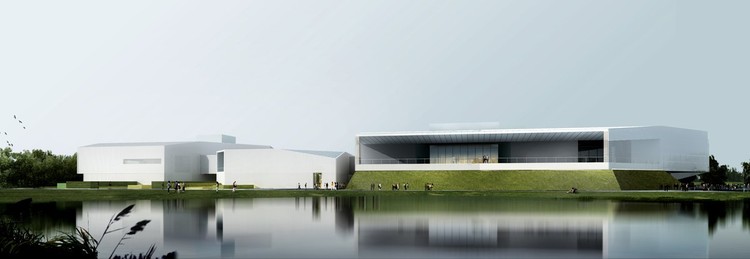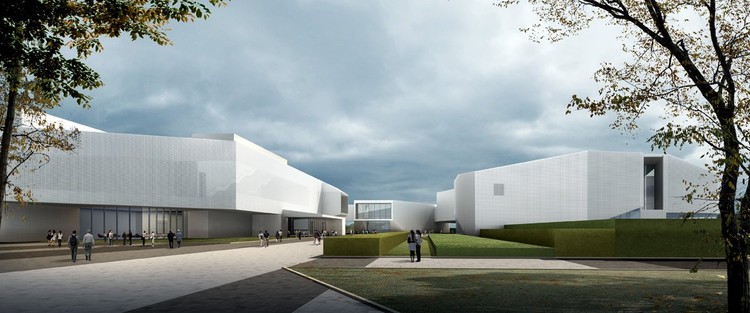
Located in natural surroundings close to the mountain, river, and wetland in the west south suburb of Beijing, Atelier 11’s proposal for the main pavilion of the Expo aims to create an artificial landscape. Rather than a manmade construction, their design echos the park’s site condition and the Expo’s particular theme. Simplistic form, unique spaces, and flexible planning become elements that both facilitate and influence one another in the overall design. More images and architects’ description after the break.
The architects take Taihu Rocks as the inspiration for the key concept behind the architectural form. Taihu Rocks are a kind of picturesque garden stones taken from the shores of Lake Taihu in South China since Song Dynasty dated back more than 1000 years ago and widely used in Chinese classical gardens. Referred to the combination of simplicity and spiritualism in the characteristics of Taihu Rocks, a form resulted from natural cutting and spreading becomes the ultimate design.

As a natural element and irreplaceable component in garden art, the rock is considered an ideal representation for the beauty of garden culture in the new era. And under the understated appearance of Taihu rocks, there lie in an intimate relationship with the local geographical character and a more profound influence from the philosophical theories in the traditional Chinese culture.

Although the Pavilion is designed for a specific event, keeping the functionality of the architecture after the Expo is also a main concern in the design process. Housing the exhibition spaces, visitor experience center, research center, and all the related facilities, the design of the Pavilion adopts a flexible space system in which big spaces could be re-organized due to the different demands for shows and conferences and small spaces are reserved for individual functional requests. The architects on one hand put the whole building into a uniformed 9mx9m column system. And on the other hand, a number of display spaces are created indoors based on the same uniformed column system but with different scales, in order to fulfill the various space demands for exhibiting flowers, rockery, and potted landscapes. Furthermore, also inspired by the flexible path design in the Chinese classical gardens, the architects create a diverse communication network to connect the different exhibition spaces, which greatly enriches the diversity and levels in the quality of the space.

The form would attract the visitors to explore the world of garden culture in the architectural space resembling rocks and caves. And in the regular column system, they could experience different spaces with changes in heights and scales. It is a space designed to provide an accessible platform for all the visitors to enjoy exhibitions, educational programs, exchanges, and activities on garden culture.

Architects: Atelier 11 Location: Beijing, China Design Director: Xu Lei Design Team: Gong Meng Client: Committee of the 9th China (Beijing) International Garden Expo Construction Area: 30,000 sqm Competition: 2010.12
























